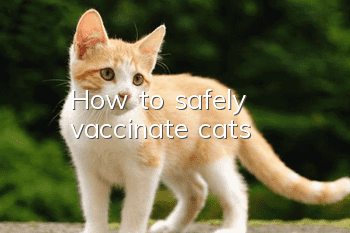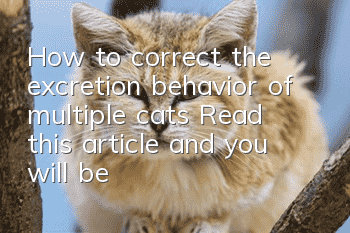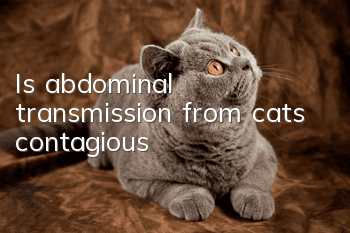How to safely vaccinate cats?

Cat vaccines are divided into core vaccines and non-core vaccines. Core vaccines are vaccines for pathogens that are highly dangerous to cats, while non-core vaccines are vaccines for pathogens that are less dangerous to cats. To put it simply, core vaccines are vaccines that must be administered, while the selection of non-core vaccines is based on the distribution of pathogens in different regions and countries, as well as the virus conditions in the environment where cats live.
1. The core vaccines for cats: feline parvovirus (i.e. feline distemper/feline panleukopenia), feline herpesvirus type 1, feline calicivirus, rabies virus vaccine, among which the combination vaccine of the first three vaccines is common Cat triple vaccine.
2. Non-core vaccines for cats: feline leukemia virus, feline HIV, feline infectious peritonitis virus, feline chlamydia, and Bordetella bronchiseptica vaccine.
The so-called combined vaccine is a combination of vaccines for two or more diseases. Generally speaking, the more vaccines are injected, the less stable the immune effect will be. Each vaccine has its own characteristics and its own immunity duration. Similar to the wooden barrel principle, the duration of the combined vaccine is the shortest one among the several vaccines in the combination. In other words, if the duration of the three vaccines in a triple vaccine is 1 year, 2 years and 3 years respectively, then the combined vaccine should be given a booster shot once a year. Otherwise, once the immunity duration of one of the vaccines (usually a non-core vaccine) expires, it will lose its protective effect on the animal, and the animal will be exposed to danger.
Note:
1. Kittens can only be vaccinated if they are over 60 days old (about 10 weeks). In kittens less than 10 weeks old, the antibodies obtained from breast milk have not disappeared. If the vaccine is injected at this time, the vaccine and antibodies will interact, which will make the injected vaccine lose its preventive effect.
2. After the first injection of vaccine for kittens or cats receiving vaccination for the first time, they should be vaccinated again (called booster injection) about 4 weeks apart.
3. Generally, subcutaneous injection of vaccine is used on the shoulder and back
4. Vaccines must be refrigerated at 2 to 8 degrees Celsius
5. The skin must be thoroughly disinfected before vaccination.
6. After injection of the vaccine, as the immune system begins to react, symptoms such as fever, mental deterioration, loss of appetite, drowsiness, etc. may occur. These are normal reactions and will usually recover on their own in 1-3 days. After the injection, the cat should be provided with adequate nutrition and vitamin supplements.
7. After vaccination, there is a certain protection rate, but the protection rate is not 100%. This shows that vaccinated cats may also contract infectious diseases if they come into contact with sick cats when their resistance is reduced.
8. It takes about 7 days after the vaccine is injected to produce a certain amount of antibodies, so the injectionWithin one week after vaccination, you should avoid taking baths and going out.
9. If you want to receive additional rabies vaccine, cats over three months old can be vaccinated. After injection, the immunity is valid for one year and should be immunized once a year.
10. Feline triple vaccine and rabies vaccine cannot be mixed and injected in the same syringe, including the use of the same syringe for injection
11. Vaccines that need to be mixed with diluent and dry powder for injection must be mixed at the time of use. The mixed vaccine will be ineffective.
12. The Taiwanese-translated instructions for Fudao’s cat pentavalent vaccine states: It should be injected into cats over 8 months old. Pregnant female cats cannot be injected. The foods with the highest allergy rates are beef, dairy products and fish.
4. Intestinal flora imbalance.
5. Stress. Stress reactions such as stress, anxiety and maladaptiveness given to animals by the environment.
Because cats cannot eat food that is too salty, let alone shrimp, squid, ham sausage and spoiled food. In addition, cats are allergic to irritating foods. If they are fed these foods, they will inevitably have gastrointestinal problems, such as diarrhea, diarrhea, and diarrhea. The stool is unformed. Therefore, it is healthiest for cats to eat specialized cat food. Fish and rice porridge cannot meet all the nutritional needs of cats, and cats are carnivores and cannot obtain nutrients from rice. Moreover, cat food is good for cats’ teeth. Long-term soft food will cause cats to develop dental diseases.
Many owners find that their babies have diarrhea or soft stools and always like to give them some antidiarrheal drugs or antibiotics. This is wrong. Some pharmaceutical ingredients used by humans can cause poisoning reactions in animals. For example, drugs containing acetaminophen can cause poisoning in cats. So please don’t use human drugs on animals without understanding them.
So what should we do? When a cat poops abnormally, parents must first determine whether the situation is serious. If you only have occasional mild constipation, scientific dietary adjustments can also improve this abnormal stool situation. On the contrary, if your pet cat has severe constipation or has had abnormal defecation for a long time. So, as an owner, you should take your cat to the hospital first. If a food allergy is suspected, discontinue that food.
To treat severe constipation in cats, enema, medication or surgery may be required. And the treatment must be completed with the help of a veterinarian. As a parent, you should not give your cat diarrhea drugs casually, let alone give your cat an enema or perform surgery.
- There are brown spots on the skin near the cat’s ears
- How to treat cystitis in cats?
- Tips for using cat teasing sticks, wrong actions will cause them to lose interest!
- Why do cats snore?
- What is the reason for serious tear stains in British Shorthair cats?
- What are the training methods and precautions for Persian cats?
- Does a cat still recognize its owner after being separated for a long time?
- How to shut up a cat that keeps meowing?
- Can you eat ice cream after being bitten by a cat?
- Can cat ringworm skin disease be transmitted to humans?



